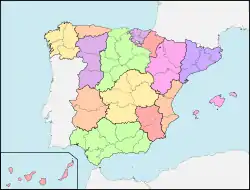Murcian Spanish
Murcian (endonym: murciano) is a variant of Peninsular Spanish, spoken mainly in the autonomous community of Murcia and the adjacent comarcas of Vega Baja del Segura and Alto Vinalopó in the province of Alicante (Valencia), the corridor of Almansa in Albacete (Castile-La Mancha). In a greater extent, it may also include some areas that were part of the former Kingdom of Murcia, such as southeastern Albacete (now part of Castile La Mancha) and parts of Jaén and Almería (now part of Andalusia).
| Murcian | |
|---|---|
| murciano | |
| Pronunciation | [muɾˈθjano, -ˈsja-] |
| Native to | Spain |
| Region | Murcia, Andalusia (Almería, partially in Jaén and Granada), Castile-La Mancha (Albacete) and Valencia (Vega Baja, Alicante) |
| Spanish orthography (Latin script) | |
| Language codes | |
| ISO 639-3 | – |
| Glottolog | None |
 | |
The linguistic varieties of Murcian form a dialect continuum with Eastern Andalusian and Manchego Peninsular Spanish.
Murcian is considered a separate language of Spanish by some of its native speakers, who call it llengua murciana.[1][2] The term panocho is also used to designate the Murcian language, however it mostly refers to the variety spoken in the comarca of the Huerta de Murcia.
History


Murcian emerged from the mixture of several linguistic varieties that joined in the Kingdom of Murcia after the conquest of the Crown of Aragon and the Crown of Castile between 13th and 14th centuries. The linguistic varieties were mainly Tudmir's Romance (a type of Andalusi Romance), Arabic, Aragonese, Old Castilian and Occitano-Catalan.
Usage
Murcian is considered an endangered language.
Phonetic features of Murcian
The Murcian dialectal features differ among areas, villages, social classes and individuals in accordance with the communicative situation in which they are involved, this is because of the influence of standard rule. This dialect has similarities and differences with Spanish, Aragonese and Catalan languages.
Vowels

As Eastern Andalusian and Southern Manchego Peninsular dialects, Murcian has 5 tense vowels (roughly the same as standard Spanish): [a], [e], [i], [o], [u], plus 3 lax vowels (not present in standard Spanish): [æ], [ɛ], [ɔ]. Vowels are lowered when in contact with an omitted coda: fricative (/s/, /θ/ and /x/) or liquid (/l/, /r/); additionally a vowel harmony process may take place; e.g. la casa [la ˈkasa] ("the house") vs las casas [læ ˈkːæsæ] ("the houses"). Notes about the Murcian vowels:
- In some cases [ɛ] approaches [æ]: seis [ˈsæj] 'six'.
- Some accents use two additional allophones: [ɪ] and [ʊ].
- Vowels are often phonetically nasalized when in contact with a nasal consonant. Nasalization is particularly strong when in contact with palatal consonants and velar consonants: munchos [ˈmũn̠ʲtɕɔ ~ ˈmũn̠ʲdʑɔ ~ ˈmũn̠ʲɟʝɔ] ('much, a lot').
Consonants
The consonant system of Murcian is mostly the same as Castilian.
Notable features, several shared with other southern dialects of Spanish:
- The spirant consonants [β ð ɣ] are pronounced as fricative consonants or close fricatives more frequently than in Standard Spanish.
- Palatalization of initial /l/ (/l/ to /ʎ/): llengua [ˈʎẽŋgwa] ('tongue').
- Final /l/ is pronounced [ɾ] before consonants (sal blanca [ˈsæɾ ˈblaŋka] 'white salt'), [l] before vowels (sal azul [ˈsæl aˈθu] 'blue salt'), and it is silent at the end of an utterance: sal [ˈsæ] ('salt').
- Final /ɾ/ is elided: El Palmar [ɛɾ paɾˈmæ].
- Some speakers have a residual /ʃ/ (or [ɕ]).
Phonetic development of Murcian
There are linguistic phenomena that are (or were) usual in other linguistic varieties (Aragonese, Mozarabic, Catalan, Andalusian, etc.):
- The frequent preservation of voiceless intervocalic consonants or other voiceless consonants that used to be voiced or are voiced in standard Spanish: cocote (cogote in Spanish), cocotazo, cancro (cangrejo in Spanish), parata (parada), sermonata (sermonada), atoba (adobe), acachar, alcayata, engangrenar, cangrena, pescatero, pinato (pino joven), gayato (cayado), falluto (huero), capolar, Caputa (a place in Mula), caparra (garrapata), capítulo (cabildo), súpito (súbito), molata, La Mulata, escorrata, pescatero, Ficaria (a place in Blanca), poyata (Lorca), volandero, etc.
- The frequent voicing of voiceless consonants: gambusino (campesino), morga (morca), alhábega (albahaca), chiguito (chiquito), regüestar (recostar), bambulla (lat. ampulla), etc.
- The frequent preservation of Latin group cl: clamar, 'llamar' and also "pl" (plantaje, El Plan).
- The frequent preservation of Latin group fl: flama (llama, calor), flamante (llameante), flamar, suflama/soflama, inflar, infleta, botinflar, botinflao, etc.
- The frequent maintenance of Latin /f/ in its original form (fenazar, fenás, vafada, fito a fito, manifacero, ferrija, Ficaria, figue, etc.) or aspirated (it is always aspirated before /u/ like in huerte, huerza, huente, humar, humo, conhundir, etc.; it is maintained in certain cases before /o/ like in hormar, hondo, hongo, hopo, etc. and before /a/ in haldar, hambre, etc.
- The presence of the intervocalic consonant cluster ns: ansa, nansa, pansa, pansir, pansío, suspensar, ansín, ansina, etc.
- A consonantal alternation between voiceless /k/ and /t/: La Rápita or La Rápica, tavacote (cavacote), tápena (caparis), friolenco, cantamusa, a tatas (a catas < a gatas), chito (chico, in Cieza), etc.
- Change from b to m: mandurria, Menjú (Abenhud, from Arabic Ibn Hud), meneno, comenencia, moñiga, camota (cabota), etc.
Evolution of certain consonant clusters
- /bd/ > [dː] (Abdón > Addón)
- /bg/ > [ɡː] (Novgorod > Noggorod)
- /bs/ > [sː] or [s] (absorver > assorver / asorver)
- /bt/ > [tː] (obtener > ottener)
- /bx/ > [xː] or [x] (objetivo > ojjetivo / ojetivo)
- /kn/ > [nː](tecnología > tennología)
- /ks/ > [s] (examen > esamen)
- /ksk/ > [kː] (excursión > eccursión)
- /ksf/ > [ɸː] (Oxford > Offor)
- /ksp/ > [pː] (explicar > epplicar)
- /kst/ > [tː] (extra > ettra)
- /kt/ > [tː] or [t] (exacto > esatto; doctrina > dottrina > dotrina)
- /kθ/ > [θː] or [θ] (lección> lición; producción > predución)
- /db/ > [βː] (adverbio > avverbio)
- /dk/ > [kː] (adquirir > acquirir)
- /df/ > [ɸː] (adfirmar > affirmar)
- /dm/ > [ɡm] > [mː] (admirar > agmirar > ammirar)
- /dx/ > [xː] or [x] (adjetivo > ajjetivo; adjuntar > ajuntar)
- /ft/ > [tː] (difteria > ditteria)
- /ɡd/ > [dː] > [d/ð] (Magdalena > Maddalena > Madalena)
- /ɡl/ > [l] (iglesia > ilesia)
- /ɡm/ > [mː] (magma > mamma)
- /ɡn/ > [nː](indigno > indinno)
- /lr/ > [rː] (alrededor > arreor)
- /mb/ > [mβ] or [mɸ] (enviscar > enfiscar; enblanquecío > enflanquecío)
- /mn/ > [nː] (columna > colunna)
- /ngl/ > [nl] (Inglaterra > Inlaterra)
- /nm/ > [mː] (inmenso > immenso)
- /pn/ > [ɡn] > [nː] (apnea > annea)
- /ps/ > [sː] (epsilón > essilón; epilepsia > epilessia)
- /pt/ > [tː] (septenil > settenil; aptitud > attitú)
- /pθ/ > [θː] (Leipzig > Leizzi)
- /rl/ > [lː] (Carlos > Callos)
- /rn/ > [nː] (carne > canne)
- /rm/ > [mː] (hermano > hemmano)
- /rs/ > [sː] (comerse > comesse)
- /sb/ > [βː] or [ɸː] (desbordar > evvordar / effordar; esvarar > evvarar / effarar)
- /sd/ > [ðː] or [θː] (desde > dezze)
- /sf/ > [ɸː] (esfera > effera)
- /sɡ/ > [ɣː] or [xː] (desgarrar > ejjarrar; desgargolar > ejjargolar)
- /sk/ > [kː] (escapar > eccapar)
- /sl/ > [lː] (eslomar > ellomar; isla > illa)
- /sm/ > [mː] (mesmo > memmo; golisma > golimma)
- /sn/ > [nː] (fresno > frenno)
- /sp/ > [pː] (asperar > apperar)
- /sr/ > [rː] (desroñar > erroñar; Israel > Irrael)
- /st/ > [tː] (castaña > cattaña)
- /tl/ > [lː] (Atlántico > Allántico)
- /tn/ > [ɡn/ > [nː] (etnología > ennología)
- /θɡ/ > [ɣː] or [xː] (mayorazgo > mayorajjo)
- /θk/ > [kː] (bizcocho > biccocho)
- /θl/ > [lː] (hazlo > hallo)
- /θn/ > [nː] (biznaga > binnaga)
See also
Notes
- En difensa la llengua murciana. Llengua maere.
- Llengua maere
- Based on the vowel chart in "llenguamaere.com - LA PLANA E LA LLENGUA MURCIANA". Retrieved 16 June 2017.
Bibliography
- Alberto Sevilla. Vocabulario Murciano
- García Soriano. Vocabulario del Dialecto Murciano
- García Cotorruelo-Emilia. Estudio sobre el habla de Cartagena y su comarca.
- Molina Fernández, Patricio. Parablero Murciano.
- Muñoz Cortés-Manuel. El habla de la Huerta.
- Aguilar Gil, Pedro. Raíces, habla y costumbres de los huertanos. A.A.V.V. Torrealta. Molina. 1999.
- Álvar López, Manuel. Estudios sobre las hablas meridionales. Universidad de Granada. Granada. 2004.
- Álvar López, Manuel. Las hablas meridionales de España y su interés para la lingüística comparada. Atlas Lingüístico de Andalucía, Tomo 1, nº. 2. Universidad de Granada. Granada. 1956.
- Díez de Revenga, Francisco Javier y De Paco, Mariano. Historia de la literatura murciana. Editora Regional. Murcia. 1989.
- Ibarra Lario, Antonia. Materiales para el conocimiento del habla de Lorca y su comarca. Universidad de Murcia. Murcia. 1996.
Further reading
- Monroy, Rafael; Hernández-Campoy, Juan Manuel (2015), "Murcian Spanish" (PDF), Journal of the International Phonetic Association, 45 (2): 229–240, doi:10.1017/S0025100314000231